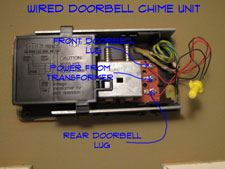 Wired doorbell chimes are the part that makes the bell or chimes ring. There are a lot of different doorbell manufacturers with a lot of different models. The chime units themselves are architectural units and may be quite costly. So fixing them can be worth the effort
Wired doorbell chimes are the part that makes the bell or chimes ring. There are a lot of different doorbell manufacturers with a lot of different models. The chime units themselves are architectural units and may be quite costly. So fixing them can be worth the effort
You have a low voltage wire coming in from the transformer and additional wires coming in from one two or more doorbell buttons. The wired doorbell chimes ring differently for the different doors. One key thing is to check the connections for the low voltage doorbell wiring. An obvious loose or corroded wire should be fixed. The other big question would be, whether or not you are getting power from the transformer.
You can use voltage meter to check and see if you have power first to the chime unit from the transformer and then AC power to the transformer. Carefully use the leads on a multi meter or a voltage sensor to see if you have power. A low voltage sensor should be used at the chime unit and the outbound side of the transformer. A 120V AC sensor can be used at the inbound side of the transformer. Repair faulty wiring when you find it. Remember to turn the power off before messing with the wires.
Side Note: A note about testing circuitry. Meters and testers are other tools that you may need from time to time. For as little as twenty or thirty dollars you can arm yourself with a couple of voltage testers and a multi meter. I would suggest a standard voltage tester, a low voltage tester (non-contact testers are the best) and an inexpensive multi meter. Multi meters are a little tricky to use, try these resources for additional information, Using a Multimeter, for more information. With this testing equipment you will be able to trace down what is happening with electrical items in your home.
If you find that you have proper current and the buttons are in good order, then it is the chime unit. Time to go to the home improvement store and find another one. Pick out one you like and can afford. Follow the installation instructions. Presto, you now have a new doorbell and completed your doorbell wiring repair.
WARNING!! Make Sure the Power is OFF!!! BEFORE You Work on Electrical Devices!!!
Fixing Wired Doorbell Chimes
We are headed into uncharted waters here. Not really, but there are a lot of different doorbell manufacturers with a lot of different models. The chime units themselves are architectural units and my be quite costly. Simply put, you have a low voltage wire coming in from the transformer and additional wires coming in from one two or more doorbell buttons. The chimes ring differently for the different doors. One key thing is to check the connections for the low voltage wiring. An obvious loose or corroded wire should be fixed. The other big question would be, whether or not you are getting power from the transformer.
You can use voltage meter to check and see if you have power first to the chime unit from the transformer and then AC power to the transformer. Carefully use the leads on a multi meter or a voltage sensor to see if you have power. A low voltage sensor should be used at the chime unit and the outbound side of the transformer. A 120V AC sensor can be used at the inbound side of the transformer. Repair faulty wiring when you find it. Remember to turn the power off before messing with the wires.
Side Note: A note about testing circuitry. Meters and tester are other tools that you may need from time to time. For as little as twenty or thirty dollars you can arm yourself with a couple of voltage testers and a multi meter. I would suggest a standard voltage tester, a low voltage tester (non-contact testers are the best) and an inexpensive multi meter. Multi meters are a little tricky to use, try these resources for additional information, Using a Multimeter, for more information. With this testing equipment you will be able to trace down what is happening with electrical items in your home.
You can use voltage meter to check and see if you have power first to the chime unit from the transformer and then AC power to the transformer. Carefully use the leads on a multi meter or a voltage sensor to see if you have power. A low voltage sensor should be used at the chime unit and the outbound side of the transformer. A 120V AC sensor can be used at the inbound side of the transformer. Repair faulty wiring when you find it. Remember to turn the power off before messing with the wires.
If you find that you have proper current and the buttons are in good order, then it is the chime unit. Time to go to the home improvement store and find another one. Pick out one you like and can afford. Follow the installation instructions. Presto, you now have a new doorbell and completed your doorbell repair.

